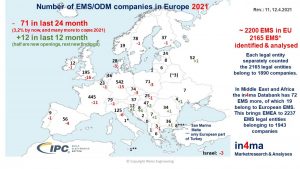Hope dies last
By Dieter G. Weiss, in4ma Market research & Analyses
 The European electronics industry is in panic. The supply situation for various components is catastrophic. As in the last allocation crisis in 2018, many buyers have not learned anything and are busy ordering double and triple in the hope of getting something at least somewhere. The results are lists of requirements or orders from component manufacturers or component dealers, which indicate that the demand is far higher than is actually required.
The European electronics industry is in panic. The supply situation for various components is catastrophic. As in the last allocation crisis in 2018, many buyers have not learned anything and are busy ordering double and triple in the hope of getting something at least somewhere. The results are lists of requirements or orders from component manufacturers or component dealers, which indicate that the demand is far higher than is actually required.
The component manufacturers have of course taken advantage of the situation and price increases of 400-500% are no longer uncommon (e.g. power electronics). Requirements that were previously blocked by a customer and released again suddenly rise massively in price, as if automatic programs (bots) bid on the product and the price is driven up within a few seconds.
In addition, some component dealers have cut direct access to their systems. So if you were able to enter the dealer’s system with your BOM in the past and then knew what you could get and when, you will no longer see anything. It’s like going to get something from the windowless warehouse and someone turns off the light. This makes it impossible to plan delivery dates. Some EMS now only have a visibility of sales and deliveries for four weeks.
Interestingly, a trend is also developing that was already evident in 2018 with regard to allocation problems. Large component manufacturers are considering why they still need an intermediary and whether it would not be better (and more profitable) for them to market their products directly and eliminate the intermediary.
The EMS companies speak to their customers with the aim of concluding framework agreements lasting until the end of 2023. At the same time, prices are increased and corresponding agreements are changed in such a way that in the event of further price increases for the components, the additional costs can be passed on and there is a purchase guarantee for components that were planned within the framework of the framework contract. In many cases, down payments are also agreed upon.
What sounds so natural has in some cases not been implemented consistently. Prices are being raised too hesitantly, and some are still intimidated by buyers who claim they can buy cheaper elsewhere. If you want to risk the existence of your company, you allow it, no one else can be intimidated by such stupid arguments.
As unlikely as it sounds, digitization also has an impact here. As part of the introduction of EMS SCOUT (www.ems-scout.de), we pointed out that 50% of buyers now live and work completely digitally and therefore need digital assistance when pre-selecting a production partner for electronics (EMS). But there is a second effect that is unfortunately not necessarily positive. Some buyers also believe that sourcing electronic components is just as easy as ordering something from Ebay or Amazon. Accordingly, it does not come as a surprise when people are halting the factory lines in the automotive industry and think it will be possible to restart everything at the push of a button. Participation in an event like EMS-Tag (www.ems-tag.de) could be an instructive training course for many dispatchers and buyers.
What influence do the current developments have on the EMS industry in Europe? In the European EMS annual statistics from in4ma in cooperation with IPC, the analysis of the German EMS companies had shown that the smaller the company, the greater the loss in sales in 2020. The query of the forecast can mostly be summarized in such a way that almost all companies assume that it will be possible in 2021 to achieve sales at the level of 2019 again and then to have very good (mostly double-digit) growth again from 2022.

In the 70-page analysis report, in4ma pointed out that this assumption was incorrect from our point of view. We don’t just have to repeat this now, we will even correct our forecast of the European EMS sales 2021 downwards after further analysis within the next four weeks (companies that have not participated in the Europe EMS annual survey can purchase the report from in4ma). You shouldn’t be confused by press reports from some associations that talk about an upswing because incoming orders have increased massively. When the industry notices that it has to plan in longer timeframes to ensure security of supply and thus also to order, then the order intake goes up massively. If, however, other associated components are postponed in the delivery date due to a missing part, then sales do not increase and can even decline in some cases. In this case, a high book-to-bill factor is shown, which is no reason to cheer or should lead to the statement that the industry is going up.
We also reaffirm the statement that the number of EMS providers in Europe will decrease by 30% in the next 10 years. 71 EMS providers have already left the market in the last 24 months. This does not include the companies that were bought up by another EMS company. In the last five months alone, the number of mergers has increased massively: e.g. VDL bought tbp electronics, Katek SE bought Leesys, Turck Duotec bought ml & s, Connect Group bought IKOR and Sero bought Solid Semecs. In the case of insolvencies, it will probably primarily affect smaller EMS, which in the past had very low equity, hardly any financial reserves, are now forced to build up stocks in order to remain able to deliver and, in parallel, are too hesitant to implement price increases.
The EMS industry in Europe, which currently accounts for almost 10% of the global production volume, remains turbulent and exciting.











